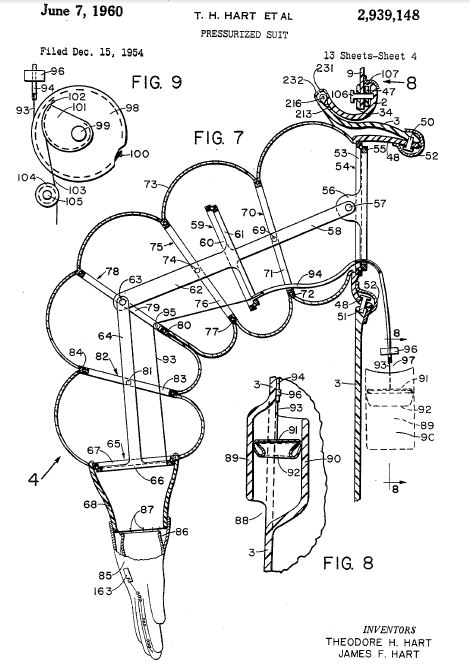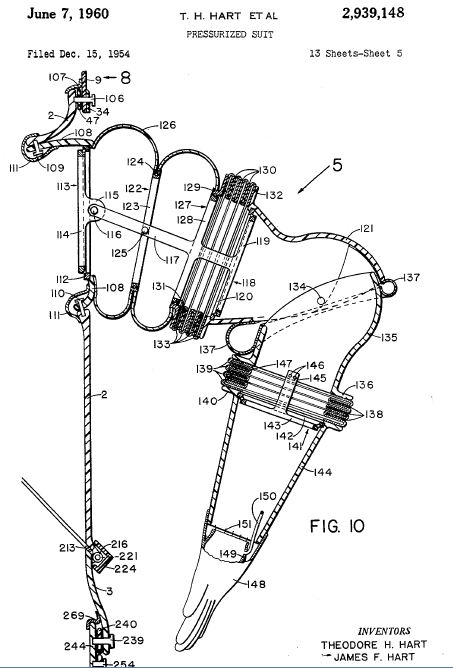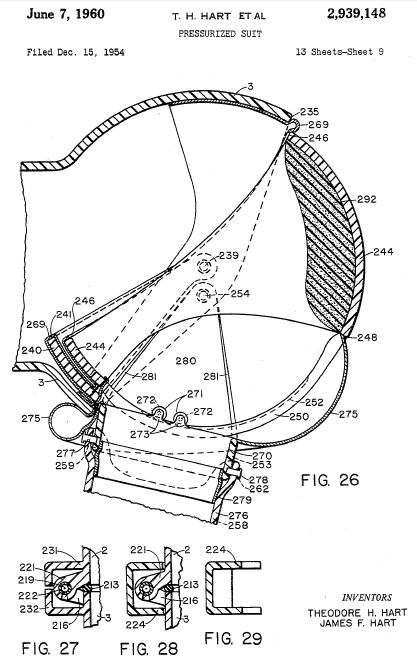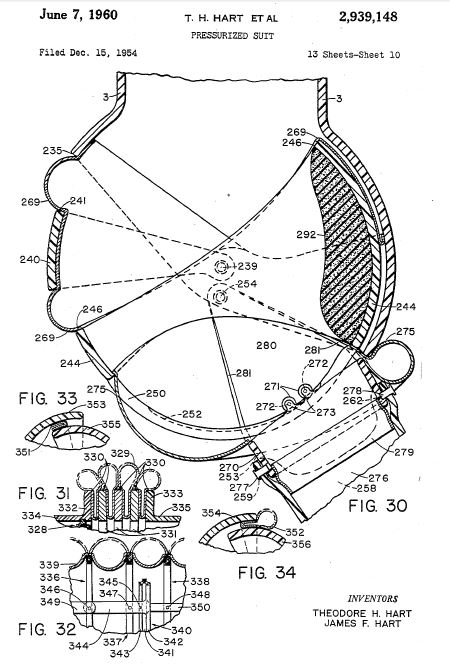1954 – Pressure Suit by James Hart and Theodore Hart
Patent Name: Pressurized suit
Publication number US2939148 A
Publication type Grant
Publication date Jun 7, 1960
Filing date Dec 15, 1954
Priority date Dec 15, 1954
Inventors James F Hart, Theodore H Hart
Original Assignee James F Hart, Theodore H Hart
This invention relates to pressurized suits and appurtenances thereto, especially to suits to be worn by aviators, divers, and others who are subjected to containment or perform certain duties under pressurized conditions.
Flight at high altitudes and beyond earth's environs has many advantages; but such flight has been limited heretofore, by many problems, among them, in part, the physiological considerations involved as exemplified by lung alveolar oxygen pressure, aero-embolism or "bends," and body gas expansion or "acute indigestion."
Diving to great depths in liquids has many advantages; such as, retrieving sunken military and commercial material.
Performing duties and/or containment in toxic surroundings is often required; for example, when the adjacent atmosphere contains lethal gases.
Performing duties in a fluid that cannot be contaminated by the gases required for suit occupant breathing and/or ventilation is sometimes desirable; for example, an industrial process that requires entrance by suit occupant into the processed media.
Performing duties and/or containment either all or in part in fluids that vary greatly from suit occupants temperature has many advantages; for example, as a military omni-environment suit, or the suit or suit portion may be submerged into a fluid of extreme temperature during an industrial process.
One object of this invention is to provide a suit dome with improved downward visibility, with provision for entering the dome wearing a crash helmet, the dome utilizing occupant's head to cause fore and aft movement thereby preventing a feeling of claustrophobia on the occupants part by maintaining a constant distance between occupants eyes and front of dome and the dome having a fluid-tight connection to the torso portion of the suit.
Another object is to provide a movable shoulder piece roughly duplicating the movement of the shoulder in relation to the body and joined to the torso by a fluid-tight connection.
Another object is to provide a movable fluid-tight connector between upper and lower arm in which the joint pivots about one axis only and is dependent on rotary seals which permit full twisting movement.
Another object is to provide a movable fluid-tight connector between upper and lower arm in which the joint is an integral part of the whole arm.
Another object is to provide a compensating device to assist in the movement of any joint that should inherently require effort to move due to trapped fluid volume change in the suit during joint movement.
Another object is to provide "feel" in the hand by use of novel types of glove and pressure regulating devices.
Another object is to provide a suit formed in two sections, joined across the body, which may be donned and doffed by the occupant without assistance.
Another object is to provide a closing device that assures uniform sealing of the body halves, notwithstanding the irregularity or extent of the sealing surfaces and that may be operated by one lever that entails for operation just one uniform motion.
Another object is to provide a movable fluid-tight means for rotating the torso portion of the suit with respect to the hip portion.
Another object is to provide a fluid-tight joint at the hips, fully movable in the fore and aft direction, that will permit the suit occupant to sit, stoop and stand.
Another object is to provide fluid-tight joints at the legs, movable fore, aft and sideways.
Another object is to provide fluid-tight knee joints which swing fore and aft.
Another object is to provide a suit in which body and limb members are formed of rigid sections, flexible sections with rigid end portions, or flexible sections with a rigid framework, all sections with flexible sealing means connecting them, and constructed in such a manner as not to ride up on the occupants body nor distend from occupants limb extremities when suit is pressurized.
Another object is to provide a suit that is for the most part made of rigid materials for durability and protection to the occupant.
Another object is to provide a suit with novel joint connections between body and limb sections that greatly increases permitted amounts of movement with a substantial reduction in effort.
Another object is to provide a diving suit construction that will remain habitable when internal pressures are either greater or less than external pressures and will enable the occupant to be taken from the water with a greater internal pressure, permitting last stages of decompression to occur in a decompression chamber with suit removed.
Another object is to provide a suit or suit portion operatable in toxic, non-contaminative or intemperate atmospheres.
See other early Underwater Robots here.




